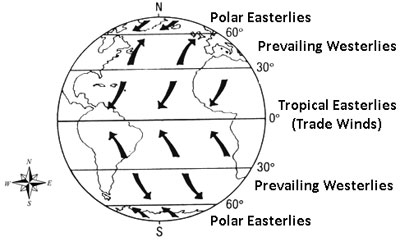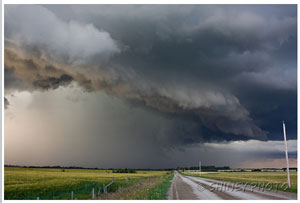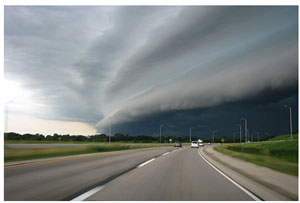
Source: Global wind patterns, NASA
Which of the following statements best describes why wind is important?
A. Global winds regulate the earth’s environment by circulating and distributing heat.
B. Wind systems are responsible for increased global warming.
C. The global wind belts reflect solar energy and heat back into space.
D. Wind patterns are responsible for the regulation of oxygen in the Earth’s atmosphere.
A.
Correct! Global winds distribute heat and regulate the earth’s environment.
B.
Incorrect. Global warming is primarily caused by human activities.
C.
Incorrect. Think about which processes would move heat that is absorbed by Earth.
D.
Incorrect. Remember that wind moves heat and cold across the Earth’s surface.
Which of the following descriptions best explains global wind systems? Use the map to answer the question.

Source: Global wind patterns, NASA
A. They are divided into circulation systems that are based upon the locations of where air rises and sinks.
B. The global wind belts cause the change of earth’s seasons.
C. There are six categories of wind systems that are divided by region and longitude.
D. They are all wind belts that move westward because of the earth’s rotation.
A.
Correct! There are three circulation systems in the Northern Hemisphere and three in the Southern Hemisphere.
B.
Incorrect. The seasons are a result of the earth’s tilt on its axis.
C.
Incorrect. Notice that the wind systems in the northern and southern hemispheres have the same names.
D.
Incorrect. Look again at the map and notice that the wind systems move in different directions.
Imagine that these storms are located in the United States. Based on what you know about global wind systems, which of the following descriptions of these storms is most accurate? Use the photographs to answer the question.
 Source: August 11-09 Storm, The Shiney One, Flickr |
 Source: Oncoming Storm, Terren in Virginia, Flickr |
A. The storms shown will travel from the southern United States to the northeastern coast.
B. Storms like these generally move from north to south in the United States.
C. These storms are most likely traveling from the west toward the eastern United States.
D. A storm in the United States would originate in the Caribbean and would travel westward toward California.
A.
Incorrect. Storms in the southern United States would be pushed toward the east by the prevailing winds.
B.
Incorrect. Remember that the earth’s rotation causes wind systems to move to the right or left.
C.
Correct! Most storms in the United States are moved by the prevailing westerlies, which travel from west to east.
D.
Incorrect. Remember that the trade winds in the Caribbean move winds toward the south/southwest.
Which of the following statements is the most accurate conclusion based upon the information given? Use the excerpt and map to answer the question.
Most hurricanes in the Atlantic basin form as a wave or piece of energy off the west coast of Africa. They tend to move East to West because of upper level steering winds and trade winds that blow out of the northeast about 10-15 degrees north of the equator.

Source: Global wind patterns, NASA
A. Hurricanes from West Africa travel south toward Zambia and South Africa.
B. Hurricanes formed off the African coast are likely to strike land in Spain, France, or Argentina.
C. Hurricanes usually travel east to west because of the prevailing westerlies.
D. Hurricanes formed off the coast of Africa are likely to hit in the Caribbean.
A.
Incorrect. The tropical easterlies would push these storms westward.
B.
Incorrect. Notice that the winds that move into Spain and France are the prevailing westerlies, not the trade winds that push hurricanes.
C.
Incorrect. Look again at the excerpt and read about what causes hurricanes to travel east to west.
D.
Correct! Trade winds move these storms westward into the Caribbean.